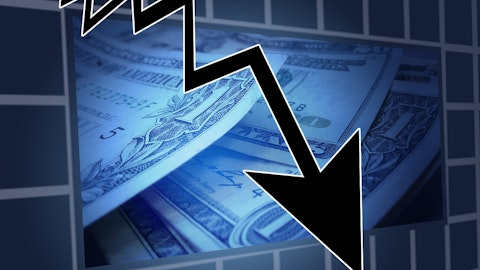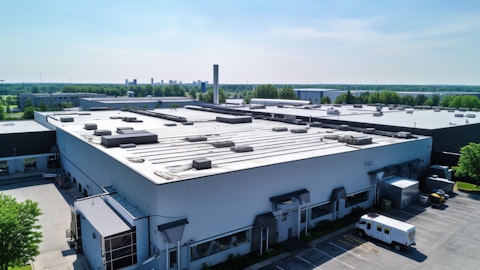David Huang: Okay. Got it. And then on raw material, how much was the raw material costs during the quarter? And I guess, when do you expect the deflation benefits to peak?
Frank Sullivan: Sure. Matt, do you want to take that?
Matthew Schlarb: Sure. Yeah. So, we — raw materials were down about 5% in the second quarter. Now, other things like labor are still going up and it varies by product category, like some things, particularly in the Consumer segment like acetone was up 25%, metal packaging and TiO2 were pretty flat, propellant was little bit up, but other raw materials were down, that brought the overall average down about 5%. So, we think that we’ll probably hit a peak of raw material deflation sometime in the third or fourth quarter of fiscal 2024.
David Huang: Okay. Got it. Thank you.
Operator: The next question is from Josh Spector with UBS. Please go ahead.
Frank Sullivan: Good morning, Josh.
Joshua Spector: Hey. Good morning, Frank. So, I just wanted to follow up on the comments on SG&A. So, your inflation in the first half is about 8% year-on-year, talked about some discrete items driving that and some actions to reduce that in the second half. So what are your expectations for second half SG&A inflation and how does that carry into ’20 — fiscal ’25?
Frank Sullivan: Sure. You can see SG&A, re — grow at a lesser rate in the second half of the year, particularly in the fourth quarter as we round our performance last year. And as we talked about, there are some specific areas that we are committed to investing in, in relationship to being in a good position to capture growth when the market turns. Matt mentioned one of those today. We committed tens of millions of dollars to the establishment of a new R&D center. It’s part of our Wood Finishes Group and our Specialty Coatings Group. Their performance in the last year hasn’t been particularly good because of their direct or indirect exposure to things in housing, which has been a really tough market environment. Nonetheless, we are committed to investments there, to investments in our Legend Brands business in terms of air handling and de-humidification equipment in a number of areas there.
We have been investing significantly in some new product categories in our Consumer Group. And we’re seeing placements of some new DAC spray products and re-capture of some Rust-Oleum market share as well coming this spring. So, we’ve been very deliberate about the balance between harvesting MAP savings and reinvesting in what we believe is future growth opportunities.
Joshua Spector: Yeah. I guess…
Frank Sullivan: Yeah. I would add one other thing to that. We track that growth investment spending separately. And so, if we get to the point where the soft landing turns into something a little more difficult economically, our ability to turn on a dime and cut tens of millions of dollars of SG&A would — could happen pretty quickly.
Joshua Spector: Thanks. No. That’s helpful. And if I kind of carry that forward, so, could you remind us of the expectation for the realized MAP to growth savings in fiscal ’24, excluding raw material and price cost movements? And your comments on investment, has that increased versus your prior expectations in that, maybe the realization of those savings is less because you’re investing more, or is it the same calculus you were running too, previously?
Frank Sullivan: Sure. I’ll let Matt give you the details on the numbers in terms of what we communicated, but our investment programs are essentially the same. So while they haven’t increased in terms of the things that we’ve been doing in the MAP program, at this stage they also have not been cut back. So, we are committed to a number of initiatives in — across a number of SBUs, with a goal of being in a good position to harvest growth when the economy gets a little bit stronger.
Matthew Schlarb: Yeah. And related to the MAP savings, in prior calls, we communicated a run rate basis of $160 million and a P&L rate of about $100 million. We’re still on-track for that. The thing is, those savings and those benefits are actually being masked by a lot of the under-absorption we’ve had from lower-than-expected volumes.
Joshua Spector: Okay. Thanks, guys.
Operator: The next question is from Jeff Zekauskas with J.P. Morgan. Please go ahead.
Frank Sullivan: Good morning, Jeff.
Jeff Zekauskas: Hi. Good morning. As a base case, how much is variable compensation likely to be up this year?
Frank Sullivan: I don’t know that we have that number specifically, but in a number of our businesses, we have addressed commercial disciplines that didn’t exist before in terms of some CRM programs and other things, such that we’ve replaced some old compensation structures in Tremco Roofing and part of our Construction Products Group with more variable compensation associated with pricing and margin. And so, that’s part of the increase in SG&A which goes hand-in-glove with the increase in gross margin profitability.
Jeff Zekauskas: Okay. And can you make some general remarks on your outlook on demand in the United States over the next 12 months in your various businesses and how you think it might change as the year progresses?
Frank Sullivan: Sure. Back to the Construction Products Group and Performance Coatings Group, we’re really well-positioned with what continues to be a huge slug of federal stimulus in the areas that we have long been positioned to serve. And so, I think we feel pretty good about that over the next 12 months. The halt of the most aggressive in history interest rate rise campaign by the Fed, will start to produce some better results. I mean that our Specialty Products Group in particular, their largest business unit is our Industrial Coatings, wood, wood stains, and finishes. We sell into items that directly or indirectly go into new homes whether it’s windows, doors, wood trim, and those markets have been negative since December of last year, which if you go back and model their declining performance, because the first six months of fiscal ’23 were great.




